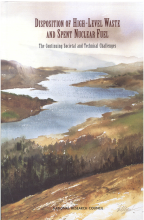Disposition of High-Level Waste and Spent Nuclear Fuel: The Continuing Societal and Technical Challenges
There has been, for decades, a worldwide consensus in the nuclear technical community for disposal through geological isolation of high-level waste (HLW), including spent nuclear fuel (SNF). However, none of the national programs established to implement geological disposal has yet succeeded in establishing a geological repository and emplacing HLW in it. The large and growing HLW inventory from civilian and military reactor use over nearly 60 years remains in surface facilities intended only for interim storage. The societal and technical challenges of geological disposal and, more broadly, of ongoing management of HLW have turned out to be substantially greater than anticipated when the United States and other nations established programs for HLW disposal starting some decades ago.
The National Research Council of the U.S. National Academies has carried out technical analyses of HLW for more than 40 years, and its reports often have been cited as supporting geological disposal as the preferred option for the management of HLW. The project that produced this report was initiated by the Board on Radioactive Waste Management, the part of the National Research Council responsible for studies on nuclear waste, in response to its observation that many nations, including the United States, were encountering significant difficulties and delays in their plans for geological disposal of HLW. The study committee includes scientists from several nations, as well as a variety of disciplinary backgrounds, and the study has addressed both the societal and the technical aspects of HLW management. In particular, the study addresses the questions of whether and when to implement disposal of HLW through geological isolation, rather than focusing exclusively on how to implement geological disposal. This report is intended to provide elected officials and policymakers, interested parties among the public, and those professionally involved with HLW with an informative overview and with specific insights to aid planning and decision making.

